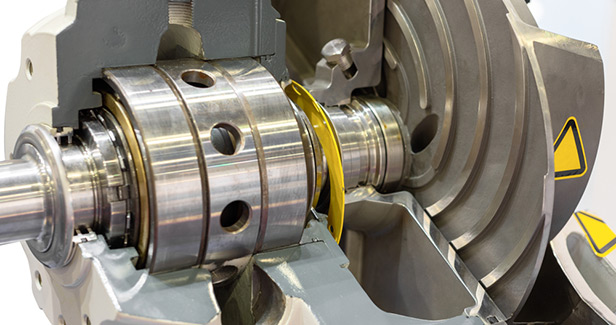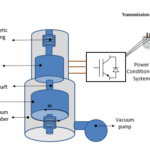Mechanical Seal Types
There are various types and arrangement of the mechanical seals being used for the centrifugal pumps. Some of the commonly used ones are described below:
1) Pusher Type of Mechanical Seals:
The pusher type of mechanical seals move axially along the rotating shaft or the sleeve to maintain the contact with the faces of the seal. This feature of these seals helps compensate for the wearing that may occur at the seal face, and wobbling due to misalignment. The pusher types of mechanical seals are used commonly, are less expensive and are easily available in the market in wide range of sizes and designs. The only disadvantage of these seals is that they tend to hang up and sometimes there is fretting of the shaft.

2) Unbalanced Type of Mechanical Seals:
The unbalanced types of mechanical seals are used under drastic conditions where there are vibrations, misalignment of the shaft, and the problem of the cavitation of the fluid. These mechanical seals are inexpensive, allow lesser leakage of the fluid and are highly stable. However, these seals can operate only under low pressure range and if the force of the fluid exceeds certain limits the lubricating film between the faces squeezes out and the seal fails.

3) Conventional Mechanical Seals:
These are relatively simple mechanical seals that have to be properly set and aligned on the shaft or the sleeve of the pump.

4) Non-pusher Type of Mechanical Seals:
As the name suggests, the non-pusher or bellow type of mechanical seals don’t have to be moved axially to maintain their contact with the faces. These seals can work under low temperature and high pressure applications. The bellows used in these seals should be upgraded so that they can work under the corrosive environments.

5) Balanced Mechanical seals:
The balanced mechanical seals have the ability to sustain higher pressures across the faces and they generate lesser heat thus they are suitable for handling liquids that have low lubricating capacity and hydrocarbons that have high vapor pressure.

6) Cartridge Mechanical Seals:
The major advantage of the cartridge seals is that they don’t require complicated setting during the installation as required by the conventional seal. This helps reducing errors associated with seal setting and eventually also reduces the maintenance required.

This part of the article is the guide for selecting the suitable mechanical seal from the various types described above. The factors to be considered when selecting the mechanical seal are type of liquid or fluid to be pumped, pressure and temperature of the liquid, nature of the liquid and the safety and environmental regulations.
Selection of the Mechanical Seal for the Centrifugal Pumps
There are various types and arrangements of the mechanical seals available in the market. It is very important to use appropriate mechanical seal for the required application. If the incorrect mechanical seal is selected there are chances that the fluid would start leaking from the pump and the very purpose of installing the expensive mechanical seal will be destroyed. In addition there would be loss of time, manpower, resources and also some safety hazards.
When selecting the mechanical seal for any applications consider the following factors:
1) Liquid or fluid to be pumped: The first and the most important factor to consider while selecting the mechanical seal for the centrifugal pump is the liquid or the fluid to be pumped. If ordinary liquid like water is to be pumped, then conventional mechanical seal with ordinary materials can be selected. In fact in many water pumps ordinary glands are used as the sealants since any leakage of water to the external atmosphere is not dangerous. But you can always see the water dripping from the pumps using ordinary glands.
If the pump has to handle corrosive liquids like acids, it is very important to select corrosion resistant materials for the mechanical seals. Some of these materials can be stainless steel, bronze or hastelloy. The mechanical seals also comprise of the mating surfaces and these should also be made up of corrosion and wear resistant materials like ceramic, silicon or tungsten carbide, carbon etc. For the corrosive environments the materials for the stationary parts of the mechanical seal can be Teflon, Buna, EPR or Viton.
Choosing the correct materials for the hazardous liquids is very important else there will all the chances that the materials would fail and the liquid would leak to the atmosphere. This can be very dangerous to the people moving around the pumps and also to the atmosphere.
2) Pressure of the liquid: The liquid enters the pump at certain pressure and the pump has to increase its pressure to certain level so that it reaches certain height. The total pressure on the seal decides whether one should opt for the balanced seal or the unbalanced type of seal.
3) Temperature of the liquid: Some pumps handle liquids at high temperatures and others handle the liquids at low temperature. The materials and mating surfaces used in mechanical seals should be able to sustain the temperature of the fluid.
4) Nature of fluid: The liquids to be handled by the pump may be having ordinary flow, but there can also be chemical solutions that have high viscosity and slow flow, there can be precipitates, there can be abrasive liquids and so on. These types of fluids usually cause more wear and tear of the parts of the mechanical seals and in such cases it is advisable to use double seals.
5) Safety and Environmental concerns: The safety of human being handling the pump is of prime importance so are the permissible emission standards. To be on the safer side it is always better to used double seals that work as the better sealants and are more reliable.


